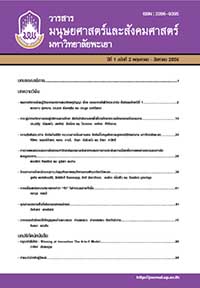การชักนำแคลลัสจากการเพาะเลี้ยงเมล็ดของข้าวหอมมะลิ 105 และข้าวเหนียว กข 6
Keywords:
การเพาะเลี้ยงเนื้อเยื่อ, ข้าวหอมมะลิ 105, ข้าวเหนียว กข 6, การชักนำให้เกิดแคลลัส, In vitro, jasmine rice 105, RD 6 glutinous rice, callus inductionAbstract
การเพาะเลี้ยงเมล็ดข้าวหอมมะลิ 105 และข้าวเหนียว กข 6 บนสูตรอาหาร Murashige and Skoog (MS, 1962) ที่เติม 2,4-dichlorophenoxyacetic acid (2, 4-D) ความเข้มข้น 0, 0.1, 0.5, 1.0 และ 2.0 มิลลิกรัมต่อลิตร เป็นเวลา 6 สัปดาห์ พบว่าสูตรอาหาร MS ที่เติม 2, 4-D สามารถชักนำให้เกิดแคลลัสได้ โดยสูตรอาหาร MS ที่เติม 2, 4-D ความเข้มข้น 2.0 มิลลิกรัมต่อลิตร ชักนำให้แคลลัสมีขนาดใหญ่ที่สุด ลักษณะแข็ง เกาะตัวกันแน่น และสีเหลือง หลังจากนั้นนำแคลลัสของข้าวเหนียว กข 6 มาเพาะเลี้ยงบนสูตรอาหาร MS ที่เติม N6 benzyladenine (BA) ความเข้มข้น 0, 1.0, 3.0, 5.0 และ 7.0 มิลลิกรัมต่อลิตร ร่วมกับ α-naphthaleneacetic acid (NAA) ความเข้มข้น 0.1 มิลลิกรัมต่อลิตร เพื่อชักนำให้เกิดต้น (ยอดและราก) พบว่า สูตรอาหาร MS ที่เติม BA ความเข้มข้น 3.0 มิลลิกรัมต่อลิตร ร่วมกับ NAA ความเข้มข้น 0.1 มิลลิกรัมต่อลิตร สามารถชักนำให้เกิดต้น (ยอดและราก) เฉลี่ย 2.4 ต้นต่อแคลลัส ด้วยเปอร์เซ็นต์การเกิดต้น 20%
Callus induction from seeds in vitro culture of rice KDML 105 and glutinous rice RD 6
Phopgao Buddharaksa1*, Warut U-kong2, Ruttaporn Chundet2, Pheravut Wongsawad3 and Mondhon Sanguansermsri4*
1 School of Pharmaceutical Sciences, University of Phayao, Phayao Province 56000
2 School of Science, University of Maejo, Chiangmai Province 56000
3 School of Science, University of Changmai, Chiangmai Province 56000
4* School of Pharmaceutical, University of Phayao, Phayao Province 56000
The seeds of rice KDML 105 (Orysa sativa L.) and glutinous rice RD 6 (Orysa sativa L.) were in vitro cultured on Murashige and Skoog (MS, 1962) medium supplemented with 2, 4-dichlorophenoxyacetic acid (2, 4-D) at 0, 0.1, 0.5, 1.0 and 2.0 mg/L for 6 weeks. The results showed that callus were induced on all the MS medium added with 2, 4-D. Significant differences were observed between the treatment. The largest callus was found on the MS medium added with 2.0 mg/L 2, 4-D with hard, compact and yellow. After that, the glutinous rice RD 6 calli were cultured on MS medium supplemented the combination of N6 benzyladenine (BA) at concentration 0, 1.0, 3.0, 5.0 and 7.0 mg/L with α-naphthaleneacetic acid (NAA) at concentration 0.1 mg/L for plant regeneration (shoot and root). The results showed that MS medium supplemented the combination 3.0 mg/L BA with 0.1 mg/L NAA was regenerated the plant (shoots and roots) average 2.4 shoots/callus with the 20% of regeneration rate.
Downloads
Published
How to Cite
Issue
Section
License
ผู้นิพนธ์ต้องรับผิดชอบข้อความในบทนิพนธ์ของตน มหาวิทยาลัยพะเยาไม่จำเป็นต้องเห็นด้วยกับบทความที่ตีพิมพ์เสมอไป ผู้สนใจสามารถคัดลอก และนำไปใช้ได้ แต่จะต้องขออนุมัติเจ้าของ และได้รับการอนุมัติเป็นลายลักษณ์อักษรก่อน พร้อมกับมีการอ้างอิงและกล่าวคำขอบคุณให้ถูกต้องด้วย
The authors are themselves responsible for their contents. Signed articles may not always reflect the opinion of University of Phayao. The articles can be reproduced and reprinted, provided that permission is given by the authors and acknowledgement must be given.








